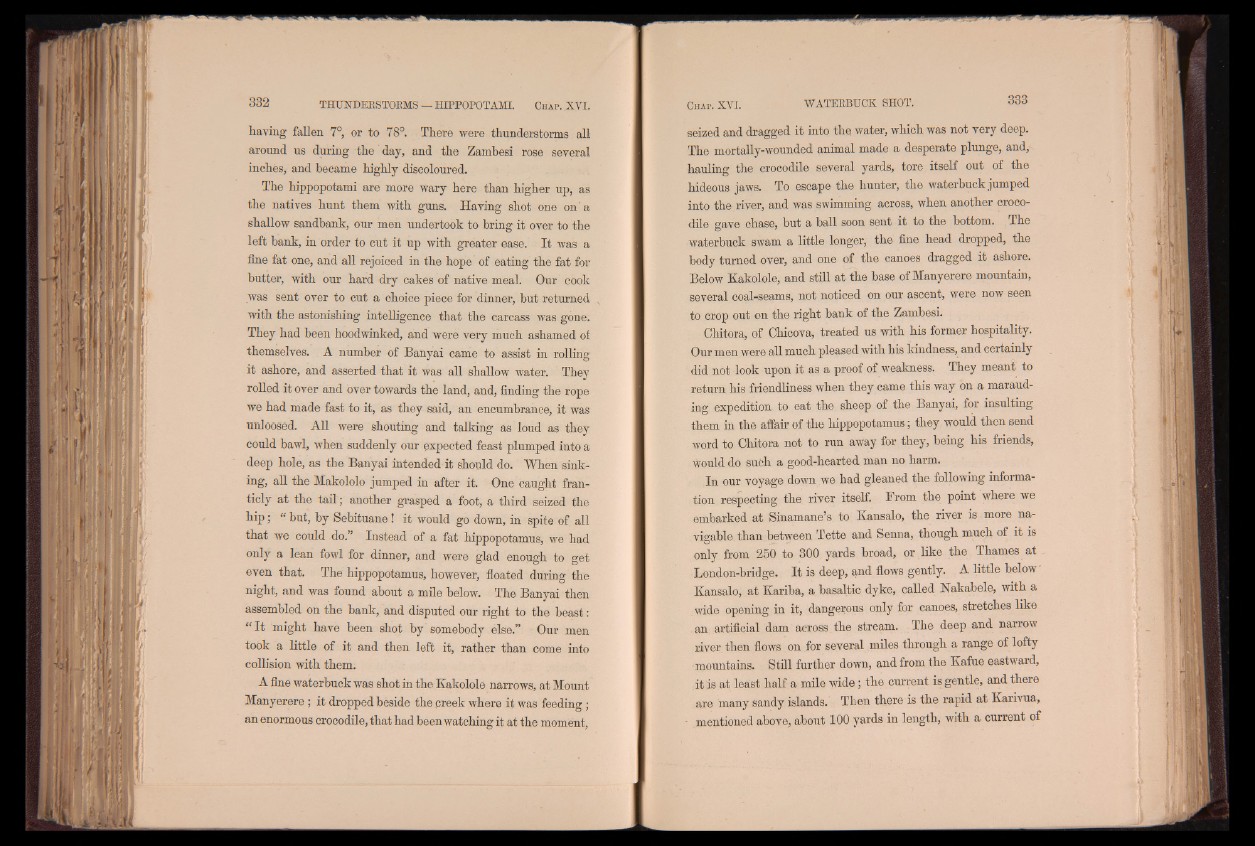
haying fallen 7°, or to 78°. There were thunderstorms all
around us during the day, and the Zambesi rose several
inches, and became highly discoloured.
The hippopotami are more wary here than higher up, as
the natives hunt them with guns. Having shot one on'a
shallow sandbank, our men undertook to bring it over to the
left bank, in order to cut it up with greater ease. I t was a
fine fat one, and all rejoiced in the hope of eating the fat for
butter, with our hard dry cakes of native meal. Our cook
was sent over to cut a choice piece for dinner, but returned
with the astonishing intelligence that the carcass was gone.
They had been hoodwinked, and were very much ashamed of
themselves. A number of Banyai came to assist in rolling
it ashore, and asserted that it was all shallow water. They
rolled it over and over towards the land, and, finding the rope
we had made fast to it, as they said, an encumbrance, it was
unloosed. All were shouting and talking as loud as they
could bawl, when suddenly our expected feast plumped into a
deep hole, as tbe Banyai intended it should do. When sinking,
all the Makololo jumped in after it. One caught fran-
ticly at the ta il; another grasped a foot, a third seized the
h ip ; “ but, by Sebituane! it would go down, in spite of all
that we could do.” Instead of a fat hippopotamus, we had
only a lean fowl for dinner, and were glad enough to get
even that. The hippopotamus, however, floated during the
night, and was found about a mile below. The Banyai then
assembled on the bank, and disputed our right to the beast:
“ I t might have been shot by somebody else.” Our men
took a little of it and then left it, rather than come into
collision with them.
A fine waterbuck was shot in the Kakolole narrows, at Mount
Manyerere; it dropped beside the preek where it was feeding;
an enormous crocodile, that had been watching it at the moment,
seized and dragged it into the water, which was not very deep.
The mortally-wounded animal made a desperate plunge, and,
hauling the crocodile several yards, tore itself out of the
hideous jaws. To escape the hunter, the waterbuck jumped
into the river, and was swimming across, when another crocodile
gave chase, but a ball soon sent it to the bottom. The
waterbuck swam a little longer, the fine head dropped, the
body turned over, and one of the canoes dragged it ashore.
Below Kakolole, and still at the base of Manyerere mountain,
several coal-seams, not noticed on our ascent, were now seen
to crop out on the right bank of the Zambesi.
Chitora, of Chicova, treated us with his former hospitality.
Our men were all much pleased with his kindness, and certainly
did not look upon it as a proof of weakness. They meant to
return his friendliness when they came this way bn a marauding
expedition to eat the sheep of the Banyai, for insulting
them in the affair of the hippopotamus; they would then send
word to Chitora not to run away for they, being his friends,
would do such a good-hearted man no harm.
In our voyage down we had gleaned the following information
respecting the river itself. Trom the point where we
embarked at Sinamane’s to Kansalo, the river is more navigable
than between Tette and Senna, though much of it is
only from 250 to 300 yards broad, or like the Thames at
London-bridge. I t is deep, and flows gently. A little below'
Kansalo, at Kariba, a basaltic dyke, called Nakabele, with a
wide opening in it, dangerous only for canoes, stretches like
an artificial dam across the stream. The deep and narrow
river then flows on for several miles through a range of lofty
mountains. Still further down, and from the Kafue eastward,
it is at least half a mile wide; the current is gentle, and there
are many sandy islands. Then there is the rapid at Karivua,
■ mentioned above, about 100 yards in length, with a current of